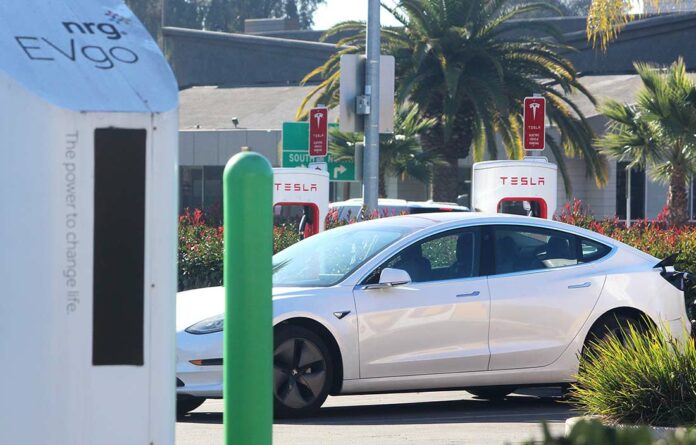
Aside from a Tesla Supercharger facility at Casa de Fruta on Pacheco Pass, San Benito County is essentially a fast charger desert. But new federal infrastructure funds may change that.
Gilroy was one of the early adopters of Tesla’s Superchargers, as the Gilroy Premium Outlets was one of the first such stations in the country when it was built in 2012. Since then, superchargers have been built at the Gilroy Crossing shopping center, as well as at the Coyote Creek Golf Club and Target in Morgan Hill.
Tesla also opened a store at 500 Automall Drive earlier this year, and recently wrapped up a renovation of the building. Just down the road, Nissan of Gilroy installed charging stations at its new facility for its customers, as the brand prepares to add new electric vehicles to its lineup.
The PlugShare website, which tracks charging stations by city, estimates Gilroy has 56 stations, all of which are east of Monterey Street and most in shopping centers.
San Jose has just shy of 1,000 ports. Santa Clara has 330, Cupertino tallies 173 and Mountain View claims 156. This isn’t a fluke.
Partially thanks to a 2018 initiative from Gov. Jerry Brown, California is currently home to nearly 23,000 charging stations—one third of the nation’s supply, according to a Pew Trust study—and the Bay Area Air Quality Management District reports 9,481 public charging ports within its nine-county region.
Yet feelings of “range anxiety” still shadow residents of this EV heaven, primarily when traveling through more rural areas. Even trekking from Sacramento to San Diego is tricky without carefully planned stops, especially for non-Tesla vehicles.
Despite being enticed by the ways electric vehicles help curb emissions connected to climate change, Kira White said she probably wouldn’t take one to visit her family three hours north in Chico. Meredith Liu says she is planning on using her husband’s gas-powered vehicle if she ever needs to commute further than her daily journey from Gilroy to Mountain View; she primarily decided to join the nearly 1.2 million electric vehicle owners on U.S. roads to save on fuel and access the fast lane, after all.
The $1.2 trillion Infrastructure Investment and Jobs Act President Joe Biden signed into law Nov. 15—the largest long-term investment of its kind in nearly a century—may convince buyers who have been on the fence.
Alongside investments in projects like replacing lead water pipes, laying cables for broadband internet and expanding public transit like Amtrak trains and city buses, Biden announced a goal of increasing the nation’s roughly 50,000 public EV charging stations to half a million by 2030. California expects to receive $384 million over five years to expand its charging network.
Some argue the lofty goal of crafting a ubiquitous network may be more hopeful than realistic, but the effort would attempt to solve one of the biggest reasons 1 in 5 EV drivers switch back to gas.
This investment in EVs may also have ripple effects locally, as more companies are jumping into the Bay Area’s electric mobility industry. Joining Tesla’s (now former) Palo Alto headquarters and Fremont factory operations, more than 200 EV companies are sprinkled around the peninsula, including Nio, QuantumScape, ChargePoint, Boson Motors, Amply Power and Tropos Technologies in Santa Clara County.
Mohamed Badawy, an assistant professor of electrical engineering at San Jose State University and founder of the school’s Center of Power Electronic Converters, sees Silicon Valley as the next Detroit, exporting electric vehicles and technologies until the industry becomes more accessible for all consumers. And while he says it was clear to him 10 years ago that electric mobility systems were the future, the country’s electronic grids, transit manufacturers and government programs are still far behind on supporting the growing need for EVs.
“It’s not going to change things a lot on the scale, but it is a step in the right direction overall for the whole nation,” Badawy said. “Even in California, which is the most advanced state in terms of EV charging, we’re still far away from where we should be. Companies are not going to build charging stations if they don’t see that there’s enough demand for them. And the demands cannot come only from one company, which is still on the high end and not for everyday Americans.”
Cost has majorly excluded people who can’t afford these vehicles from the industry, particularly college students and budding professionals like Amelia Hain—who is one of the young adults arguably with the most years left to drive. Her boyfriend, Kole Barr, has his money on hydrogen fuel cells to combat the “lesser than two evils” debate between gas and lithium ion batteries.
But cheaper solutions will likely have to be utilized to make widespread changes, since the $7.2 billion is nearly half Biden’s original hopes for a $15 billion budget.
Many of the new chargers are expected to have a “Level 2” capacity, meaning an hours-long charge will replenish around 25 miles of battery power. Many EVs can drive more than 300 miles on a fully charged battery, which takes around eight hours. That’s comparable to a standard 10-gallon gasoline tank in a mid-priced internal combustion car, which usually takes less than five minutes to fill.
These 240-volt contraptions—the same electricity needed to power washing machines—cost around $2,000, while their faster companions are 50 to 100 times more expensive, racking up anywhere from $40,000 to $400,000. PG&E reported their average cost for installing Level 2 ports through 2020 was $18,384.
No matter where drivers charge their electric cars, they’ll have to continue “sipping” power whenever they are at public destinations like multi-family residences, grocery stores, parks, hotels and even churches, as well as standard gas stations. Some EV advocates are even arguing that investments in 120-volt “Level 1” chargers will avoid even decades-old infrastructure to handle the power supply needed.
In the meantime, EV drivers like Maria Garfias will be satisfied with the cost savings and eco-friendly benefits of their personal transportation. That is, if she can reliably find working charging stations, unlike one pesky machine at Westfield Mall.
“I do wish they were as frequent as gas stations,” Garfias said, before driving away in her Mustang Mach-E—60 miles left until its battery died.









